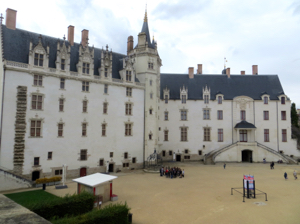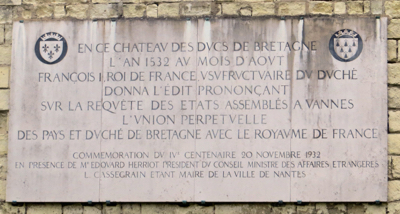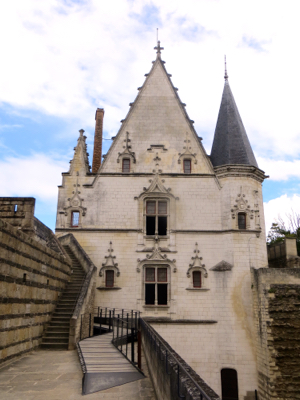 |
Château des Ducs de Bretagne, Nantes | |
| The Dukes of Britanny built a château to be both a military fortress and a ducal residence. | ||
|
|
|
The Château des Ducs de Bretagne is one of the main historic sites in Nantes. You can walk along the ramparts, wander through the gardens, and admire the ducal residence, all for free! It's right in the center of town (map), easily accessible from the train station or by tram. The ducal residence dates from the 15th century and is in flamboyant Gothic style, with some hints of the Renaissance. Made of white tufa and decorated according to the desires of Anne of Bretagne, it is elegant and stands in contrast to the rough stonework of the exterior fortress. The château is an impressive structure, with its seven towers and high walls, many decorated with the crest of the Ducs de Bretagne.
Enter the château grounds by crossing the bridge over the moat (be sure to note the intriguing staircase to nowhere...). As you enter the inner courtyard, you'll get a sense of the size of the structure, and you can admire the architecture of the ducal residence. Head to your right and climb up to the tower for your first views of Nantes and the rest of the château. From the tower you can continue to walk along the ramparts and see the entire château and the interesting views it offers. From the ramparts you can see the Lieu Unique, former home of the LU Biscuit company, and the Cathédrale de St-Pierre et St-Paul de Nantes. It's also fun to watch the ever-changing fountains of the Miroir d'eau, just in front of the château. For a tranquil stroll or a quiet place to sit, visit the moat gardens (also free). The château houses the Museum of the History of Nantes. To visit the museum and any temporary exhibitions, you will need to pay an admission fee. Although there has been a château on this site since the 13th century, the current château dates from the 15th century and later. Francis II, the last Duke of independent Brittany, and his daughter, Duchess Anne of Brittany (who was twice Queen of France), both ruled Brittany from here. In the 16th and 17th centuries, after Brittany became part of France, the château served as the royal residence when the kings of France visited Brittany. In 1532, King François I issued an edict for the "perpetual union of the duchy of Brittany with the kingdom of France" (below).
The Château des Ducs de Bretagne is a great place to begin exploring Nantes. Centrally located and not far from the train station, it is easy to access and explore. Note that the château and the museum are closed on Mondays.
|
|

Above, The elegant ducal residence of the Château des Ducs de Bretagne. The group of visitors in the middle give a sense of scale.
|




